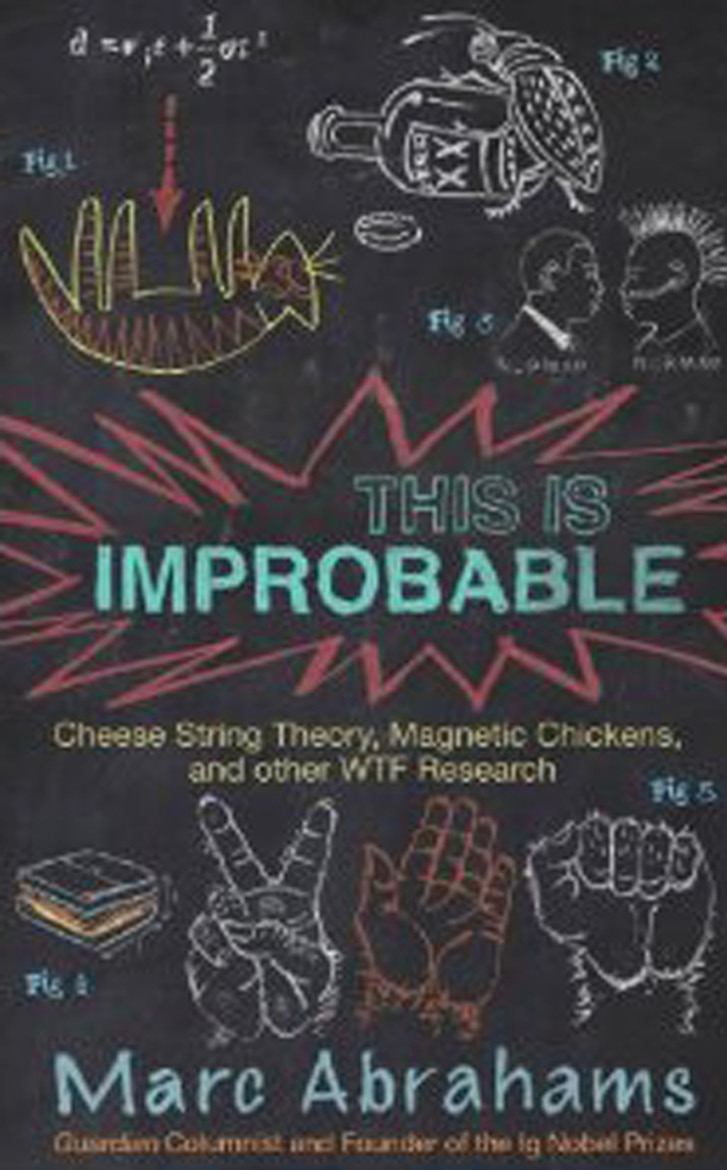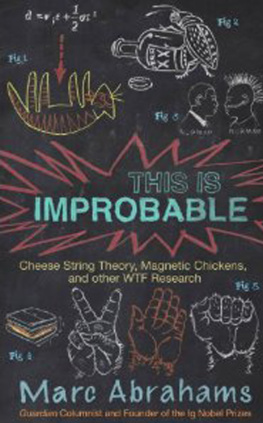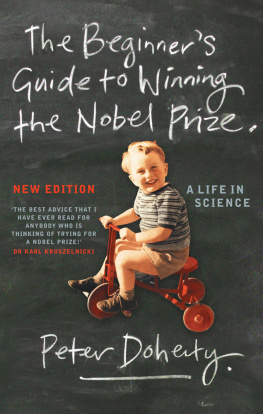

A Oneworld Book
First published by Oneworld Publications 2012
Copyright Marc Abrahams 2012
The moral right of Marc Abrahams to be identified as the Author of this work has been asserted by him in accordance with the Copyright, Designs and Patents Act 1988
All rights reserved
Copyright under Berne Convention
A CIP record for this title is available from the British Library
ISBN 978-1-85168-931-6
Ebook ISBN 978-1-78074-114-7
Typesetting and eBook design by Tetragon
Cover design copyright Andy Bridge
Printed and bound in the UK by CPI Mackays, Chatham
Oneworld Publications
185 Banbury Road, Oxford, OX2 7AR, England

Advance Praise for
This Is Improbable
After reading this hilarious book, youll never look at scientists in the same way again.
Terry Jones , bestselling author and Python
Marc Abrahams is a perfectly calibrated filtration system into which all of science is poured and out of which comes pure, giddy goofball delight. This book is a delicious, addictive treat.
Mary Roach , author of Stiff and Packing for Mars
Human beings are weird, the world is weird, and human beings just cant stop em like to research the world. The result is a triple-rainbow of weirdness, all compiled with wit and aplomb by Marc Abrahams, the worlds leading impresario of strange-ass science.
Amanda Palmer , musician and artist,
The Dresden Dolls and Evelyn Evelyn
Marc Abrahams has assembled a delightful collection of research that is as informative as it is entertaining. This is the kind of book that is a pleasure to read in the bathroom and in the bedroom, and the kind of book that makes you seem smarter when you share it with friends (just make sure you wash your hands first).
Dan Ariely , James B. Duke Professor of Psychology and Behavioral Economics, Duke University, and author of Predictably Irrational and The (Honest) Truth about Dishonesty
Wonderful! The definitive compendium of quirky, jaw-dropping research.
Richard Wiseman , author of :59 Seconds and Quirkology
Utterly hilarious.
The Bookseller
Contents
Prologue
Without Ducks
There are no homosexual, necrophiliac ducks in this book. There wasnt room. Too many other improbable stories require space here.
It can be tempting to assume that improbable implies more than that implies bad or good, worthless or valuable, trivial or important. Something improbable can be any of those, or none of them, or all of them, in different ways. Something can be bad in some respects and good in others.
Improbable is, simply: what you dont expect.
I collect stories about improbable things, things that make people laugh, then think. The research, events, people, and pages in this book defy any quick attempt at judgement (bad-or-good? worthless-or-valuable? trivial-or-important?). But dont let that stop you from trying. See what you make of these:
Measuring how cats skulk. Mechanically plucking and packaging a hijacker, then ejecting and delivering him by parachute to authorities on the ground below. Making people read inappropriately highlighted textbooks. Determining a persons natural hopping frequency. Watching volunteers as they listen to fingernails scraping on a blackboard. Monitoring the brain of a pianist as he repeats a short song non-stop for twenty-eight hours. Strolling with one shoelace untied, in country after country. Engineering a bra that can quickly convert into a pair of protective face masks. Placing a cat on a cow, then exploding paper bags every ten seconds. Optimizing the packaging for a large hollow chocolate bunny. Applying the thoughts of the French philosopher Foucault to the lives of Australian Rules football players. Adapting Jesuss strategic leadership principles for the US Army. Plumbing the psyche of fruit machine gamblers. Classifying the kinds of boredom felt by mid-level administrators in the British Empire. Surgically altering a Belgian so he resembles singer Michael Jackson. Examining porcupine copulation. Discovering that electro-ejaculation is difficult to perform on the rhinoceros.
Most of what youll read here first appeared, in some form, in my weekly Improbable Research column in the Guardian . But the plod of science does go on, and so for this book Ive dug up more details, added updates, and tossed in extra improbable titbits.
Theres more to each of these stories than I could fit into these pages, of course. Thats partly why I give you citations. Surprises await you, should you choose to follow those leads.
Theres another, more demanding reason to include the citations. Some people think these stories are fictional or exaggerated. No, friend: these are nonfiction. I have tried hard to exaggerate nothing.
Sincerely and improbably,

Editor and Co-founder,
Annals of Improbable Research
* Now, about those ducks. If you want to read about them, or find out whats happened on the several scientific research fronts that grew up in the wake of their discovery, youll have to go look on your own. The place to start is Kees Moelikers now-historic report The First Case of Homosexual Necrophilia in the Mallard Anas platyrhynchos (Aves: Anatidae), published in 2001 in the Dutch biology research journal Deinsea (see volume 8, pages 24347; no translator needed). Or take the special tour at the Natural History Museum in Rotterdam where Kees, the museums curator, one afternoon (a) noticed a sudden loud sound that turned out to be a duck fatally crashing at high speed into the museums glass wall, then (b) took up his notebook and camera to document how the event played out over the next seventy-five minutes. Or you could skip ahead to watch videos of the 2004 Ig Nobel Prize ceremony at Harvard University, where Kees was awarded that years Ig Nobel in the field of biology. Alternatively, you could read the book De eendenman (the title translates as The Duck Guy ), which Kees wrote a few years later, after a publisher nagged him to do it; the book became so popular in the Netherlands that it was reprinted five times during the first two weeks. Or you could read some of the reports Kees subsequently wrote for the Annals of Improbable Research , for which he now serves as European Bureau Chief. His reports cover many topics. Birds that spend their days repeatedly hurling themselves against a particular window. Historic murders of sparrows by cricket players and television producers. International biomedical concern about the possible disappearance of pubic lice. And more.
Many of the people described in this book are like Kees Moeliker, in at least one way. When they give their attention to a particular question, they can be entertainingly focused about it.
This Is Improbable
One
Strange in the Head
In Brief
My Grandmothers Personality: A Posthumous Evaluation
by Frederick L. Coolidge (published in the Journal of Clinical Geropsychology , 1999)
Some of whats in this chapter: Thinking, to the brink of medical danger Spotting hairy heads in theme parks Being bored for His Majesty Playing on, whilst being watched Being brain damaged, for better wagering Fingering beauty for intelligence Heading up Brain An Alias for body hair Praying, to the brink of madness.
















